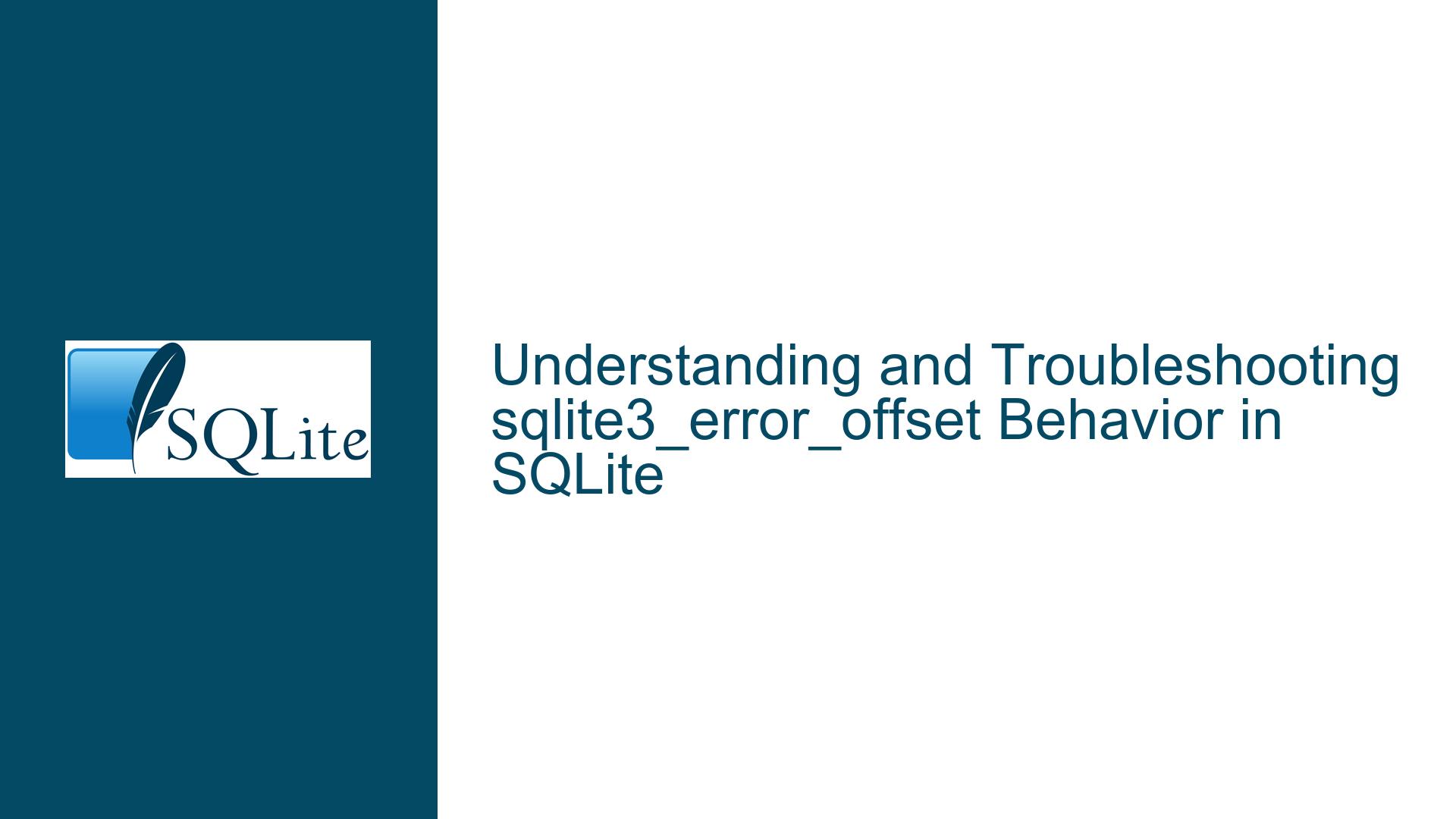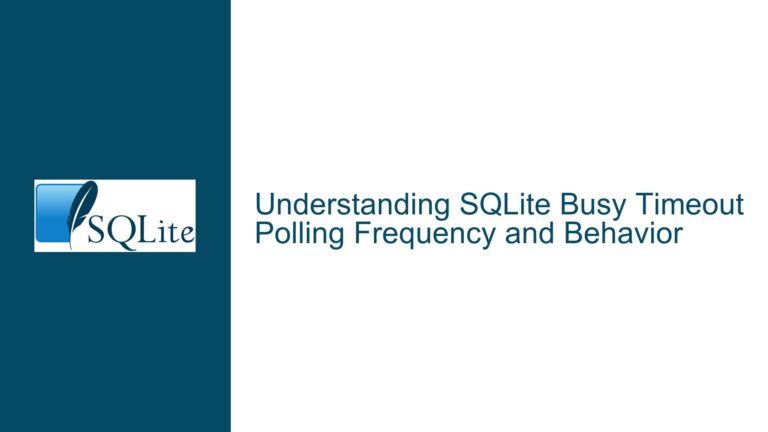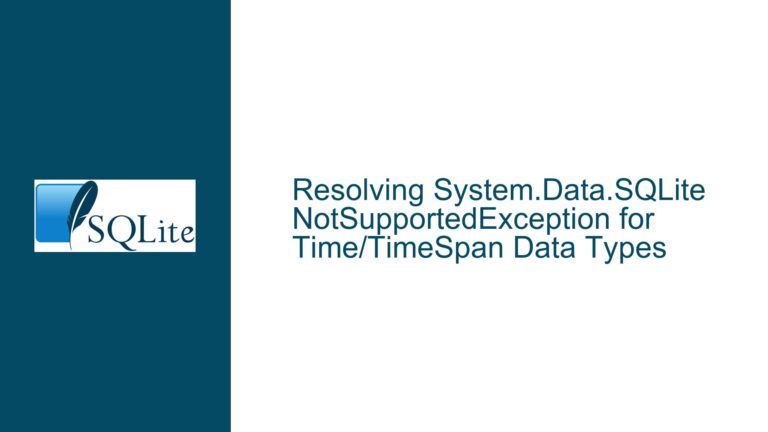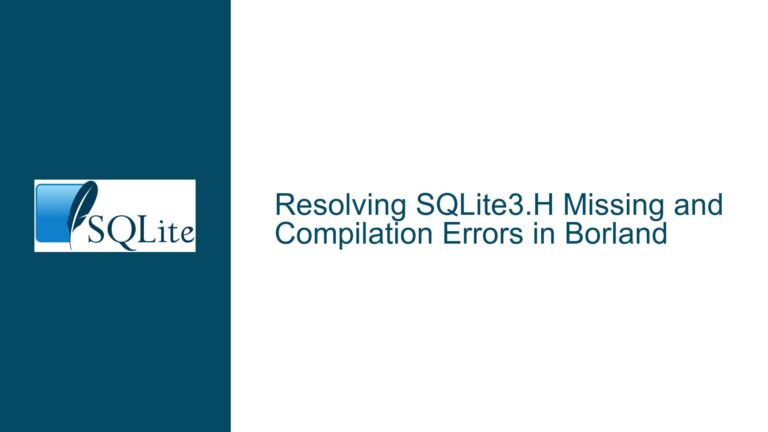and Troubleshooting sqlite3_error_offset Behavior in SQLite
Issue Overview: sqlite3_error_offset Returns -1 for Missing Table Errors
The sqlite3_error_offset function in SQLite is designed to help developers pinpoint the exact location of errors in SQL statements by returning the byte offset of the token that caused the error. However, there is a specific scenario where this function does not behave as expected: when the error involves a missing table. For example, consider the SQL statement SELECT 1 FROM nonExistentTbl. When this statement is executed using sqlite3_prepare_v2, the error message correctly indicates that the table nonExistentTbl does not exist. However, calling sqlite3_error_offset after this error returns -1, which suggests that the error does not reference a specific token in the input SQL. This behavior is inconsistent with other types of errors, such as those involving missing columns or functions, where sqlite3_error_offset correctly returns the byte offset of the problematic token.
This inconsistency raises questions about the internal workings of SQLite’s error handling mechanism, particularly during the parsing and compilation phases of SQL statement processing. Understanding why sqlite3_error_offset behaves differently for missing table errors compared to other types of errors is crucial for developers who rely on this function for debugging and error handling in their applications.
Possible Causes: Differences in Error Detection During SQL Parsing and Compilation
The behavior of sqlite3_error_offset can be attributed to the way SQLite processes SQL statements internally. SQLite’s SQL processing can be broadly divided into several stages: tokenization, parsing, semantic analysis, and code generation. Each stage has a different role in transforming the input SQL text into executable bytecode. Errors can occur at any of these stages, but not all errors are detected in the same way or at the same time.
When SQLite encounters a missing table error, such as in the statement SELECT 1 FROM nonExistentTbl, the error is typically detected during the semantic analysis phase. This phase involves resolving table and column names, checking for the existence of tables and columns, and ensuring that the SQL statement is semantically valid. However, by the time the semantic analysis phase is reached, the tokenization and parsing phases have already been completed. The tokenization phase breaks the input SQL text into tokens, and the parsing phase constructs a parse tree from these tokens. If an error is detected during semantic analysis, the information about the exact token that caused the error may no longer be readily available, especially if the error is related to a missing table.
In contrast, errors involving missing columns or functions are often detected earlier in the process, during the parsing phase. For example, in the statement SELECT y FROM x, the error no such column: y is detected during the parsing phase because the column y is referenced directly in the SQL text. Similarly, in the statement SELECT nosuchfunction(x) FROM x, the error no such function: nosuchfunction is also detected during the parsing phase. Since these errors are detected earlier, the exact token that caused the error is still available, and sqlite3_error_offset can correctly return the byte offset of the problematic token.
Another factor that may contribute to the behavior of sqlite3_error_offset is the way SQLite handles different types of errors internally. Some errors, such as syntax errors, are detected during the tokenization or parsing phases and are associated with specific tokens in the input SQL text. Other errors, such as missing table errors, are detected later and may not be associated with a specific token. This difference in error detection timing and association with tokens can explain why sqlite3_error_offset returns -1 for missing table errors but not for other types of errors.
Troubleshooting Steps, Solutions & Fixes: Handling Missing Table Errors and Using sqlite3_error_offset Effectively
To effectively troubleshoot and handle missing table errors in SQLite, developers need to understand the limitations of sqlite3_error_offset and adopt strategies that work around these limitations. Here are some steps and solutions to consider:
Understand the Limitations of sqlite3_error_offset: The first step in troubleshooting is to recognize that
sqlite3_error_offsetmay not always return the expected byte offset, especially for errors involving missing tables. Developers should be aware that this function is more reliable for errors detected during the tokenization or parsing phases, such as syntax errors, missing columns, or missing functions. For errors detected during the semantic analysis phase, such as missing table errors,sqlite3_error_offsetmay return-1.Use Alternative Debugging Techniques: Since
sqlite3_error_offsetmay not provide the desired information for missing table errors, developers can use alternative debugging techniques to identify and resolve these errors. One approach is to use the SQLite command-line interface (CLI) to test SQL statements interactively. The CLI provides detailed error messages and, in some cases, highlights the exact location of the error in the SQL text. For example, running the statementSELECT y FROM xin the CLI will produce an error message that indicates the missing columnyand highlights the location of the error in the SQL text.Check for Table Existence Before Executing SQL Statements: To avoid missing table errors altogether, developers can implement a pre-execution check to verify that all tables referenced in the SQL statement exist in the database. This can be done using the
sqlite3_table_column_metadatafunction, which retrieves metadata about a table and its columns. By checking for the existence of tables before executing SQL statements, developers can prevent missing table errors and ensure thatsqlite3_error_offsetis not needed for these types of errors.Implement Custom Error Handling: In cases where
sqlite3_error_offsetis not sufficient, developers can implement custom error handling logic to provide more detailed error information. For example, when a missing table error is detected, the application can log the SQL statement and the name of the missing table, along with any other relevant context. This custom error handling can help developers quickly identify and resolve issues without relying onsqlite3_error_offset.Consider Using a Different Database for Advanced Error Handling: While SQLite is a powerful and lightweight database, it may not always provide the level of error handling and debugging support needed for complex applications. In such cases, developers may consider using a different database system that offers more advanced error handling features. For example, PostgreSQL provides detailed error messages, including the exact location of errors in SQL statements, and supports more sophisticated debugging tools. However, this approach should be weighed against the benefits of using SQLite, such as its simplicity, portability, and low resource requirements.
Review SQLite Documentation and Community Resources: Finally, developers should review the official SQLite documentation and community resources to stay informed about the latest features, best practices, and known issues related to error handling. The SQLite documentation provides detailed information about the
sqlite3_error_offsetfunction and its limitations, as well as guidance on how to use it effectively. Additionally, the SQLite community, including forums and mailing lists, can be a valuable resource for troubleshooting and resolving issues related to error handling and debugging.
In conclusion, while sqlite3_error_offset is a useful tool for pinpointing errors in SQL statements, it has limitations, particularly when it comes to missing table errors. By understanding these limitations and adopting alternative debugging techniques, developers can effectively troubleshoot and resolve issues in their SQLite applications. Whether through pre-execution checks, custom error handling, or the use of different database systems, there are multiple strategies available to ensure robust and reliable error handling in SQLite.






